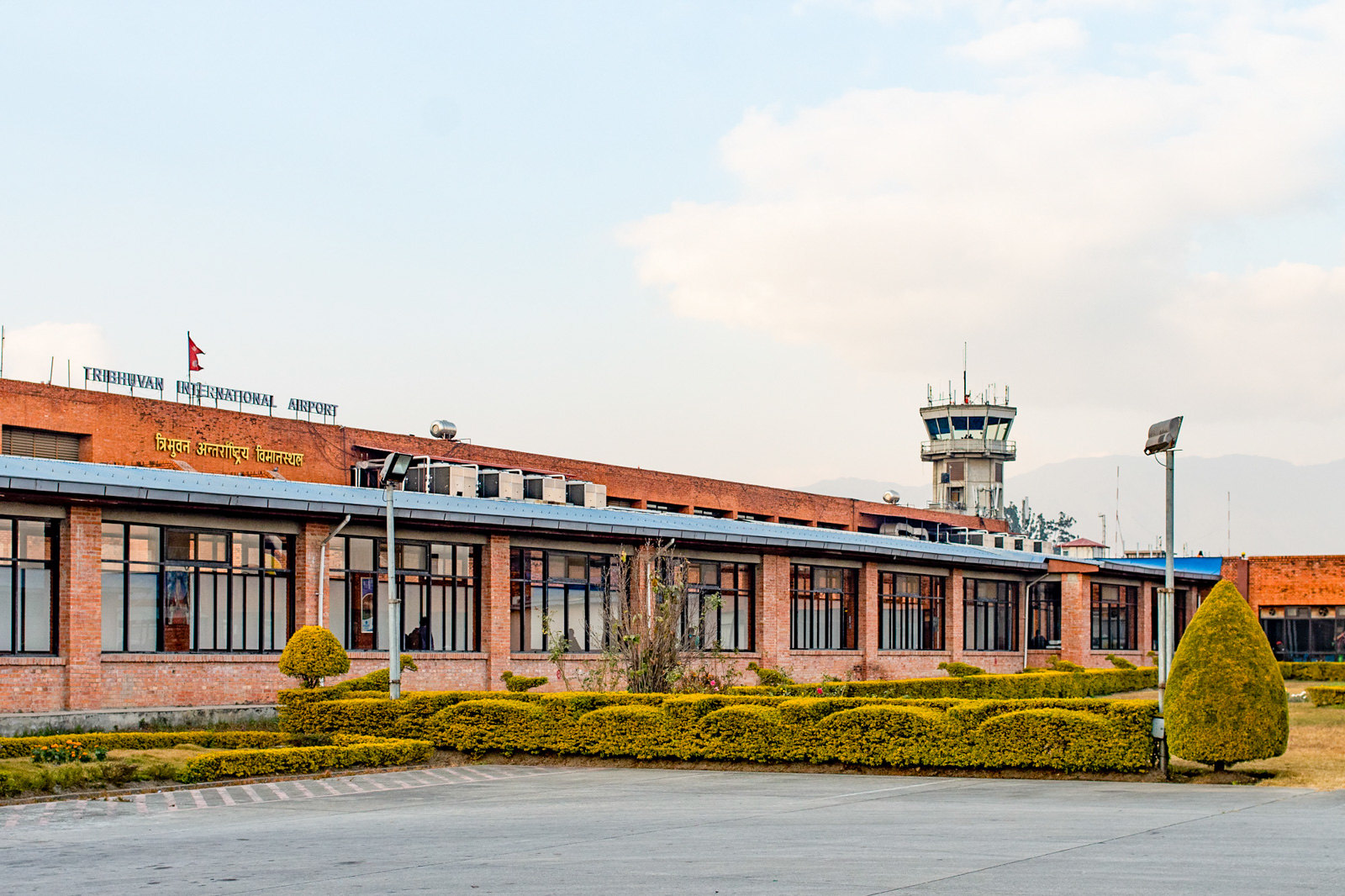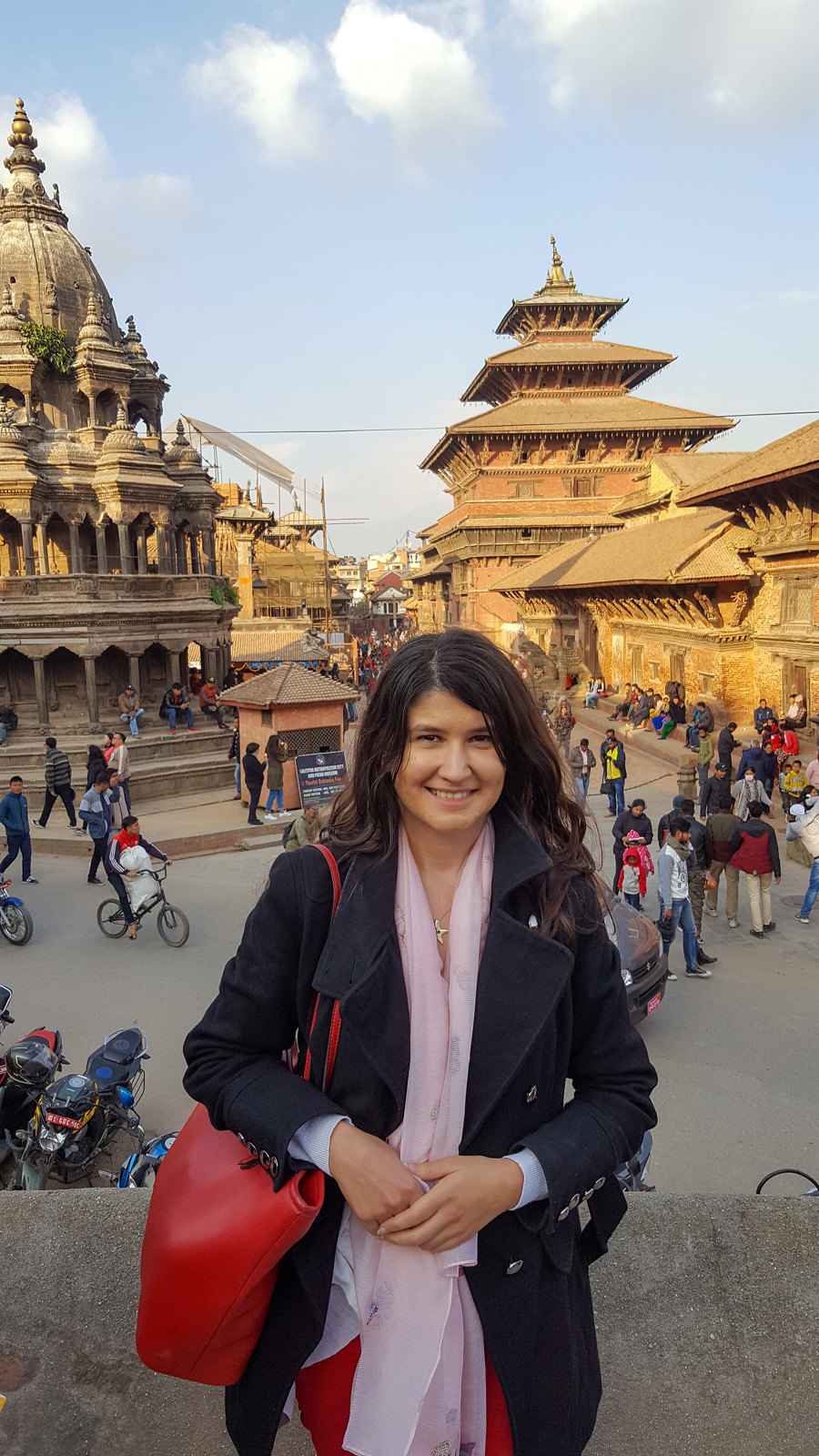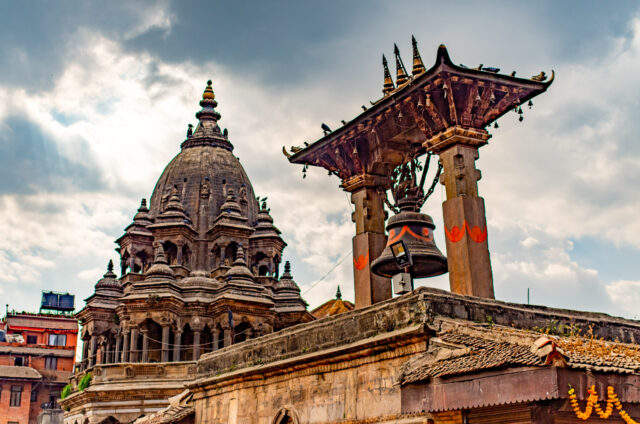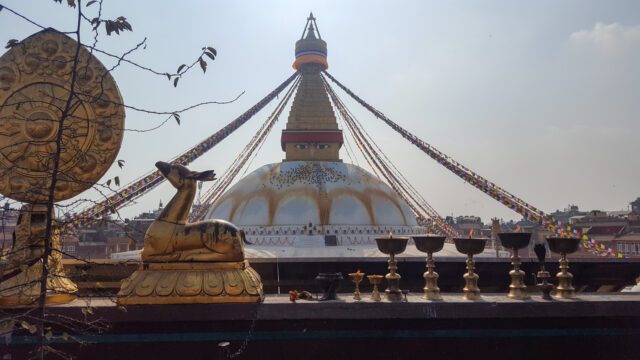Nepal is particularly well-known for its mountainous areas and hiking in Himalayas is the main reason for travelers to visit this country. It does have amazing spots with unforgettable views. However, Nepal is not only a destination for mountain lovers. It also offers rich cultural experiences and beautiful and colorful small cities.
Visa Policy
Nepal provides visa on arrival for all but 12 countries in the world. All on arrival visas are multiple entry. For this you will need Tourist form, money in cash and arrival card.
You have two options for filling the “tourist form”:
- Online tourist form: you can do this before arrival to save time (up to 15 days in advance of your arrival). You will get a barcode which you have to print and have with – though you can also get it from the machine at the airport.
- At the machines on the spot: those machines were slow and had queues, so I suggest doing this in advance online. The machines will also give you the code.
Having the barcode in hand you will go to the bank at the airport, pay the fee and get the receipt. The visa on arrival costs 30 US$ for 15 days and 50 US$ for 30 days. You should have the money in cash, card payment is not accepted.
In addition to this, you have to fill in the arrival card that you will get at the airport. With the barcode, arrival card and the receipt of payment you can then proceed to the Immigration to get the visa. This process took us over an hour because of the queues.

When to Go to Nepal
The main times people suggest to visit are October and November, because the visibility is better and you can see the amazing mountain views. Another window is March-April. Winters can be rather cold. While from May the monsoon season begins and it can get very humid and rainy.
We visited during the end of November-beginning of December. We were comfortable during the day and wore coats in the evenings. So it was overall not a bad time. But we were not very lucky with visibility, as it was mostly quite hazy.
Safety Tips for Visiting Nepal
Overall, we didn’t feel any physical danger, however, we didn’t venture too far to the non-touristy areas. We did walk a lot though, even from Kathmandu to Patan and overall it seemed all right. Simply follow general safety rules here, additional vigilance in terms of violence/theft is unnecessary.
One thing that always made me uncomfortable in Kathmandu were the numerous motorcycles and the complete nonexistence of traffic rules. The narrow streets of many parts of the city have no sidewalks, so you basically walk trying not to be run over by cars or motorcycles. Besides, there are really few traffic lights, so crossing the street is a huge deal.
Another issue is food safety. Given that water is contaminated all over the country, the fresh food that is washed in this water can make you sick. The way to avoid this is to only eat cooked food or make sure that the restaurant or café you eat at, washes the food in clean water. Also, I suggest keeping your mouth closed, while showering. And obviously, you should never drink tap water. You can buy water anywhere and it’s very cheap.
Another issue only in Kathmandu is the terrible air quality, as soon as we got out of the airport, we felt it, but when we got into the city, it was just terrible. For a couple of days our lungs were literally hurting and nose was full of black pieces. That’s the reason, why hotels offer free masks for some protection.
I have heard of a lot of scams related to trekking. The major one I have read of is the insurance scam, when the people with minor illnesses were being taken by helicopters. Apparently, some even spiked the travelers’ food. After insurance companies threatened to stop covering Nepal, the government started to take measures. Either way, be aware of such possibilities and be careful.
How to Get There
Most probably you will fly to Kathmandu Tribhuvan Airport. We didn’t find many cheap flights, the cheapest option was FlyDubai. When you arrive, keep in mind that the visa-on-arrival procedure can take a while as told above.
From the airport to the Kathmandu center you have very limited options:
- Taking a taxi: We asked our hotel to send one, as I read a lot about the taxi drivers being very pushy and requesting exorbitant prices. The hotel sent us the taxi and it was very easy to find the sign with our name on it. The driver asked for the tip in the end. We anyway didn’t have local money then, so couldn’t give, but also later found out that tipping the drivers over what is agreed is not common.
- Bus to Ratna park and walk: To take the bus, you will have to walk towards left hand side, after getting out of the airport. Ask the bus driver if they go to Ratna park and hop on. You will buy the ticket from the bus driver. From Ratna park you will have about 20 mins walk to Thamel.
What to Wear in Nepal
Overall, keep in mind that Nepal is a conservative country, so avoid wearing short shorts or other revealing clothes. We didn’t notice many restrictions on clothes in touristy areas, so I guess you can wear, whatever you like, for example, in a place like Pokhara, which is more relaxed. Anyway, if you visit during the high season, the weather won’t be so hot to allow you to wear summer clothes 😊
Also from personal experience I suggest to keep feet covered, as there is too much dirt on the streets. So I don’t advice wearing sandals.
Dress code for Buddhist and Hindu temples is typical, as in any other country – you will have to have your shoulders and knees covered, when you are entering one.

Money
In Nepal the currency is Nepalese Rupee. Cards are accepted some restaurants, cafes and ticket offices. However, you will need to have cash for many things, like taxis, food places, etc.
You can bring cash and exchange money at exchange offices. Exchange very little at the airport, given that the rates are bad, as in most airports in the world. In bigger cities, including in Thamel in Kathmandu or the main touristy areas of Pokhara, you will find a number of exchange offices. However, you may have issues in rural areas, so exchange your money before leaving the big cities. We didn’t find any particularly good exchange rate, we just compared several exchange office rates and went for one. Count your money, when they give it back to make sure they don’t give you less.
Alternatively, you can get money from ATMs (some of them may add fees, so check in advance). Make sure to get your cash in bigger cities, like Kathmandu and Pokhara, because in smaller towns ATMs may not be reliable and you may encounter problems using a foreign card.
Religion
Nepal is majority (79%) Hindu. Before visiting we were somehow convinced that majority were Buddhists, but we were wrong.
You will find colorful flags everywhere in Nepal, which are called prayer flags. They are based on Buddhist traditions. Some say they carry prayers to the gods, but really, they spread the positive energy and goodwill. The five colors of the flags represent 5 elements:
- Blue is for sky and space;
- White is for air;
- Red is for fire;
- Green is for water;
- Yellow is for earth.
All of them together show balance.
Where to Stay
Kathmandu
There are several areas liked by tourists, but most popular and full of hotels and hostels in the Thamel area. It is quite nice with a lot of restaurants and shops, which are catered to tourists, so you don’t have to worry about food safety, as in many other spots. Prices are also more or less ok, but obviously they are far more than it would be in non-touristy areas.
Another popular destination is so called Freak Street (yes, you read it right 😀 ). This is a street located near the Durbar Square, where the hippies were living in the 60-70s. Apparently there were a number of hashish shops, which were licensed by the government. It still remains popular for backpackers, but far less than Thamel.
Some people also stay near Boudhanath or in Patan, but there are less options in these areas and this makes getting around more difficult.
Pokhara
This is a lakeside area, quite relaxing and popular for the mountaineers, who venture to Anapurna – the main district with all the hotels and hostels is near the east side of the lake. There is one major street, nearby which you will find all the accommodations, as well as shops and food places.
Transport in Nepal
Intercity Buses
There are buses of various tourist companies running from Kathmandu to Pokhara, to Chitwan and to Lumbini. The buses are more or less ok. You will be able to buy tix for them from any travel agency. There are a number of companies, but they are basically the same old buses with air conditioning and cost the same – about 8 USD from Kathmandu to Pokhara, for instance.
Bus station in Kathmandu: Buses leave from the spot called Sorhakhutte on Google Maps (more specifically, this particular location). This is just a road, where all buses are parked. This place is close to Thamel and you can just walk there. You will have to find the tour company that is indicated on your ticket. It’s quite a mass there to be honest.
Bus station in Pokhara: In Pokhara there is a proper bus station, from where you can walk to the main area with all the hotels and restaurants in 15-20 minutes.
Most buses leave Kathmandu or another city you are at in the morning at about 7-7.30, so your journey will take better part of the day.
Try to get places in the front of the bus, as the roads are terrible and you will be grateful for it (when I say terrible, I absolutely mean it. We had the worst bus rides in Nepal). When you arrive on the spot, they will try to give you other seats in the back, as the locals like to sit in the front and they try to push tourists in the back. Don’t agree to this, they have to give you the seats you have on the ticket.
The road from Kathmandu to Pokhara, and generally anywhere in Nepal, is really bad, with a lot of potholes and very wavy. So it is a very uncomfortable journey, don’t be fooled. To get to Pokhara, they normally say it takes about 6-7 hours, but count more like 8-9 in most cases. The way back from Pokhara to Kathmandu was the worst, it took 9 hours and we were dying by the end of it.
Domestic Flights
There is also an option to fly between Kathmandu and various destinations: Pokhara, Nepalganj, Biratnagar, Jomson, etc. This is certainly much faster, but expensive way to get around. Flight costs start from about 100 USD.
Transport in Kathmandu Valley
To be honest, what we saw is that there is no public transport to speak of in Kathmandu. I am from Georgia and very familiar with bad public transport, such as mini buses, but Nepal is another level. We witnessed the extremely overcrowded rare buses, where I would never venture to get on. Similarly, mini buses were terrible.
That’s the main reason for numerous motorcycles I guess: People just don’t have another option. You will see the whole families on one motorcycle. And the traffic is very bad. That’s the reason for the terrible air quality as well.
Buses from Kathmandu to Bhaktapur and to Patan
They take about an hour. You will have to take them from Ratna Park. The buses stop on the street here too. We ended up at the area a couple of times and it is always massy, with tons of people waiting for the buses. Once any bus shows up, people run to it and fit in as much as they manage.

Bus signs are in Nepali, so you will have to ask locals to help you with finding the right bus.
There are a number of minibuses from Kathmandu to Bhaktapur, Patan, Kirtipur, Nagarkot, etc. They also run from Ratna park station. We tried to take them, but it was quite a mass so gave up. I am definitely not the one to travel on the roof of a minibus and with chickens, even though I am quite resilient overall 🙂
So, even though we always try to take public transport everywhere we go, Kathmandu valley was an exception, as it simply wasn’t an option. As a result, around Kathmandu valley we were either walking or taking taxis.
Taxis
Hailing taxis is expensive, especially if you are taking them from Thamel. When they see you are a tourist, they ask a lot. The ride from Kathmandu to Patan is about 500 rupees, to Bhaktapur the cheapest you can get is 1000 rupees.
instead of hailing, you can opt for other options:
- Use the taxi app: if you have internet that would be the easiest option. Most popular taxi app nowadays is Pathao. But there are also other apps, like Sarathi and Easy taxi. I suggest to have a look at several of them and compare, which would suit you best.
- Ask your hotel to order one: hotels may be helpful with ordering taxis for you at an ok price. We found this to be cheaper than bargaining after we hailed one.
Best 10-day Itinerary Tips for Independent Cultural Travel to Nepal
There are several versions of itineraries depending on your interests and wishes. I will give suggestions for the cultural trips. If you want to do mountain hiking, this is anyway almost impossible to do independently and you would need a tour company to arrange this for you. Therefore, they will provide relevant itineraries anyway.
Kathmandu Valley (5 days)
Day 1 – Explore Kathmandu – Durbar Square, Garden of Dreams, Narayanhiti Palace, Swayambunath.
Day 2 – Visit Patan (Lalitpur), Kirtipur
Day 3 – Visit Bhaktapur, Changunarayan (you can skip this), Thamel
Day 4 – Visit the Kathmandu Monasteries (Kopan, Khawalung Tashi Choeling, Shechen), Boudhanath and surrounding monasteries, particularly, Guru Khakhang, Pashupatinath
Day 5 – Visit Nagarkot
Additional days: you can see Panauti (It is very cute, but we didn’t make it there), Namo Buddha temple, Kakani area, etc.
Around Pokhara (2-3 days)
Day 6 – this day will be mainly dedicated to getting from Kathmandu to Pokhara. If you are not taking a bus and have a car, see Bandipur on the way. You can have some time to stroll at the lakeside.
Day 7 – Pokhara – World Peace Pagoda, Gupteshvar Mahadev cave, Devis falls (this was definitely not great, but it was close to the cave, so why not), take the small boat to the small island in the lake with the Tal Barahi temple.
Day 8 – Visit Sarangkot
Find detailed information on how to spend 2 days in Pokhara and around.
Day 9 – get back to Kathmandu
Day 10 – Enjoy Thamel or explore more of the valley, as suggested earlier
Alternative: Chitwan from Pokhara
Day 9 – Travel to Chitwan and spend half a day there
Day 10 – Chitwan and fly back to Kathmandu.
We spent 9 full days in Nepal and didn’t go to Chitwan, however, I hear it’s lovely.
Other Tips for Travelling Independently in Nepal
- The 2015 earthquake affected Nepal’s Kathmandu valley significantly. It damaged many amazing structures, including parts of the Kathmandu Durbar Square, Patan Durbar Square, as well as Boudnadath, etc. The earthquake had significant affects on Nepalese people and the economy, which didn’t recover from it. If you open Tripadvisor, you will see a number of negative reviews with people complaining about reconstruction and not being able to take cute photos without scaffolds in them. Please, don’t listen to these reviews and do visit. Granted, the government has been very slow with reparations, despite the foreign aid and the income from entrance fees and corruption is apparent. Some places, like Basantapur palace were reconstructed with foreign aid, while others – not yet.
- As in most parts of Asia, check prices of anything you want to buy in many spots to get the idea of what it may cost. They will definitely give you inflated price and expect you to bargain. Either way, if you are in touristy areas, expect everything to be expensive. We didn’t buy almost anything, as the tea cost as much as it would in London and we aren’t big on bargaining.
- Carry toilet paper and hand sanitizer everywhere. You will find paper in some toilets, but in many cases, you will find none. This of course is not the case in the more tourist-oriented restaurants, etc, but if it’s a public toilet or toilets at the sightseeing spots, then you should be well-prepared and careful.
- Power outages used to happen more often all over Nepal. Nowadays, it still happens, so keep it in mind and don’t be surprised. Most hotels have the backup though, therefore, they will quickly switch, in case of power outage. We encountered this only a couple of times during our stay.
- In order to enter any of the temples, you will be required to take your shoes off. To be honest, the level of cleanliness usually leaves a lot to be desired (our socks were very dirty after some visits), so I suggest taking some sort of socks or foot cover in order to avoid walking barefoot on the floor. I always keep very thick socks in my bag for this purpose.
- What I loved a lot about Kathmandu and Pokhara, were their bookshops. There are a number of bookshops, where you can get English language books for cheaper than in many places. They also have a lot of secondhand shops, so you can browse and buy great things for 2-3 USD. Or some new books for 5 USD. I got several things I have been looking for, including the Nepalese author Narayan Wagle’s Palpasa Café and Bhutanese writer Kunzang Choden’s Circle of Karma. I also found some other books, that aren’t easily findable elsewhere. Anyway, it was very difficult to get me out of these amazing shops 😀





You have lots of great tips here to help me feel comfortable in planning a trip here. Thank you!
This is a great guide!
beautiful photos.. would love to visit Nepal some day